Collecting Tables Vs. Ergosa Packer: Comparison & Evaluation
Let’s address the elephant in the room that most packaging producers avoid talking about :
8 min read
 Stefan Badertscher
:
February 11, 2022
Stefan Badertscher
:
February 11, 2022

Are you looking for a packing system to help you improve your folder-gluer’s productivity, increase your folder-gluer’s output, and reach top packing speeds?
Debating whether you should add a Collecting Table or another automated folder-gluer packer to your folding gluing line?
At Impack packaging, we manufacture and install Manual, Semi-Automatic, Automatic, and Fully-Automatic folder-gluer packers and peripherals solutions for folding gluing lines.
With over 500 units installed in over 27 countries, we know packing systems inside, out.
Collecting Tables are the most common, and longest existing, machines in the packaging industry. Some examples of the most widely present Collecting Tables in Western countries are Bobst’s Handypack GT, KBA Duran's Omega Pack Station, and Tünkers' FAS 480.

“But which is better for me? A Collecting Table or another packing system?”
“What are my options of packing systems?”
“And is a Collecting Table really the right solution for our company?!”
We get asked those kinds of questions about Collecting Tables dozens of times a week in one form or another.
And I totally get it. Every company wants to know which machine is better for them. Everyone wants to have the best packing system that will become a money-making machine rather than a money-draining pit.
And these questions are all valid and important, but sadly, you are always left with the frustrating statement “it depends” or the “book an appointment with sales” nonsense.
But that’s not what we’re going to do.
This VIDEO + ARTICLE will provide you with a complete review of Collecting Tables. This way you have all the info you need before you ever have to speak to anyone.
By the end of this article, you’ll be able to decide whether a Collecting Table is the right solution for you or not.

First, it is important for you to know that all packing systems fall into one of the following four levels of automation:
Manual packing
Semi-Automated packing
Automated packing
Fully-Automated packing
That is, there are Manual packing systems, Semi-Automatic packing systems, Automatic packing systems, and Fully-Automatic packing systems.
And by “packing systems” we are referring to any solution that is added to your folding gluing line to help you automate your case packing or bundling/stacking process. For example, folder-gluer packers, folder-gluer stackers, or any packing help/aid.
🔍 Recommended: Thinking of adding a packing system to your folder-gluer but still unsure about what level of automation your company needs? Find out the right level of automation for your company by reading “What’s the Difference between Manual, Semi-Auto, Auto & Fully-Auto Folder-Gluer Packers?”
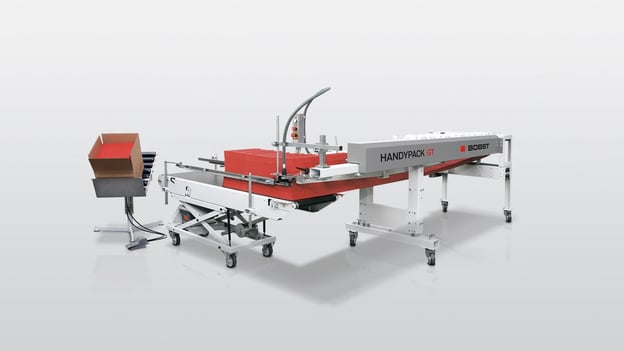
Manual packing is the lowest level of automation and usually the starting point of a folder-gluer operation.
It is the traditional packing method used for decades where the whole packing process is done manually. No automation is involved and no case management is involved in the Manual packing process.
The most common packing systems in the manual category are Collecting Tables.
Collecting Tables are Manual packers (non-automated packers) that serve as a packing help/aid to the Manual packing process.
That is, they are very basic packers and still require 100% manual work from your operators unlike a fully-equipped folder-gluer packer.
Bobst’s Handypack GT, KBA Duran's Omega Pack Station, and Tünkers' FAS 480 are some examples of the most popular Collecting Tables in Western countries.
At IMPACK, our Collecting Tables are the “Packing Help Stations.”
The first image below displays IMPACK’s “Packing Help Station 1.0” which consists of an accumulation conveyor and an actual tilting table combination.
-1.webp?width=624&name=ezgif.com-gif-maker%20(67)-1.webp)
And the second image below shows IMPACK’s “Packing Help Station 2.0” which is similar to the other Collecting Tables on the market.
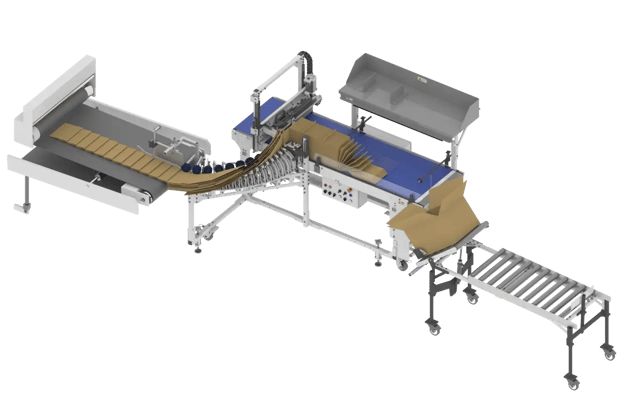
🔍 Recommended: Interested in learning more about IMPACK’s Packing Help Stations and the benefits they can offer to your packing process? Check out the article “What is IMPACK’s Packing Help Station & What Companies Is It Best Suited For?” (Coming Soon).
Packing systems that fall in the lowest end of the manual category are ones where you see multiple operators packing directly at the end of the folder-gluer's compression belt.
In other words, they would crowd a bunch of operators/packing staff at the end of the folder-gluer’s compression belt and ask them to pack as fast as they can. This is inefficient, non-ergonomic, and unproductive. Fortunately, we rarely see this happening anymore.
In addition, you would usually see basic tables made of wood or stainless steel and “tilting holders/stands” used to tilt the cases which are to be packed with the boxes.
An example of this that we saw in one of our client visits is shown in the image below:
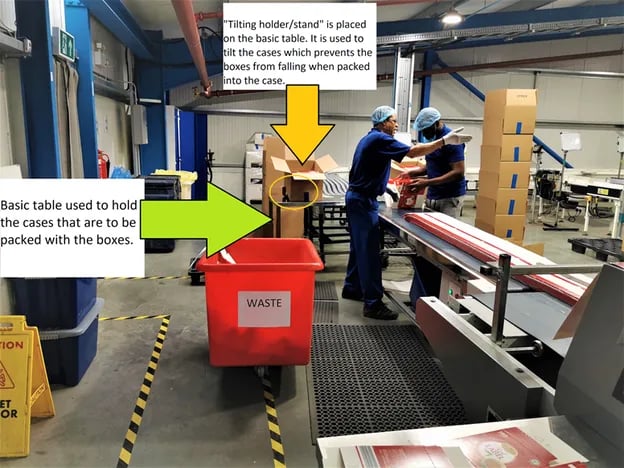
The most popular Collecting Tables on the market all have a right angle on the left or the right with a box turning feature and some form of tilting table (whether a basic table or an actual tilting table).
Some offer more capabilities than others. Ask your packaging equipment supplier about their tilting table’s specifications and level of automation.
But just like with the traditional manual packing process, you still have to pack your boxes by hand on the Collecting Table and do the case flap closing, taping, and ejecting yourself. It is full manual work with no case management involved.
This is all to say that Manual packing is the lowest level of automation and the packing systems that fall into this category (such as Collecting Tables or IMPACK’s Packing Help Stations) involve full manual work, have no automation, no case management, and they just serve as a packing help/aid to your Manual packing process.
Now that we’ve clearly defined the Manual packing process and Collecting Tables, let’s dive into the advantages and disadvantages of Collecting Tables.
Quickest and easiest installation and setup: Collecting Tables have the quickest and easiest setup of all automation solutions with virtually zero setup time.
Offers you a high level of flexibility: Given that Collecting Tables are non-automated, your operators have easy access to the machine allowing them to make adjustments, quality control checks, and corrections without ever interrupting your production.
Least expensive solution: The biggest selling point of Collecting Tables is their cost. They are by far the least expensive solution relative to Semi-Automatic packers, Automatic packers, and Fully-Automatic packers.
They facilitate an easier packing process by serving as a “Packing Help” or “Packing Aid” for the operator or packing person.
Collecting Tables are easily moveable as most of those machines are on wheels.
They give you the capability to dispose of or place boxes that are already turned 90°.
Collecting Tables allow you to slow down the shingle of boxes to the minimum possible speed by maximizing the compression of the shingle.
Not the top speed: Because Collecting Tables do not automate your case packing process and involve full manual work without any case management, they simply cannot match the speed of Semi-Automatic packers, Automatic packers, or Fully-Automatic packers.
Although called packers by some companies, Collecting Tables are simply just box turners (or Manual packing help/aid) that better present/orient the boxes for your operators or packing staff to facilitate the packing process.
Just like the traditional Manual packing process, you still have to pack your boxes by hand and do the case flap closing, taping, and ejecting yourself. The packing process is still full manual work with no automation and no case management.
Collecting Tables involve high physical strain because your operators or packing staff still have to lift loads of boxes (about 3-5 tons of carton material per shift).
The speed of the accumulation conveyor is not always synchronized with the folder-gluer’s compression belt.
Collecting Tables offer only 1 packing mode.
With Collecting Tables, you cannot choose the way you want to turn your boxes (left or right). It is fixed.
Collecting Tables have no “Straight through mode” (when turning 90° to the left or 90° to the right is not needed).
Collecting Tables are not customizable according to your production realities or constraints.
They offer limited ergonomic gains.
And they offer limited productivity gains of 10 to 25%.
In most cases, Manual packing (or Manual packers) can only help you realize limited productivity gains of 10 to 25%.
However, if you have not yet implemented our recommended top 5 ways to improve your folder-gluer’s productivity with $0 investment then you can possibly realize up to 50% productivity gains with Collecting Tables.
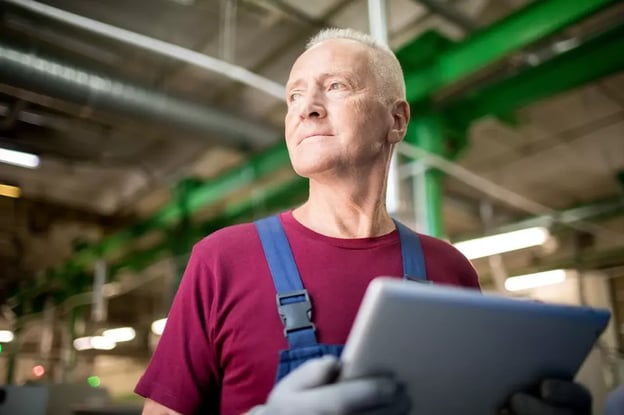
The truth is: For some packaging producers, a Collecting Table is the perfect solution.
And for others, a Semi-Automatic packer or an Automatic packer is the better option.
And sometimes, you have no choice but to go for a Fully-Automatic packer.
It all depends on your production, box configuration, needs, goals, and budget.
But I won’t leave you at just that.
👉 If you have small production runs with lots of changes per shift, a very tight budget, and you’re not ready to automate your case packing process, then investing in a Collecting Table could be a great start.
Examples of the most popular Collecting Tables in the Western market include: IMPACK’s Packing Help Stations, Bobst’s Handypack GT, KBA Duran's Omega Pack Station, and Tünkers' FAS 480.
You should take into consideration though that those Collecting Tables do not include case management so your operators will have to take care of the case flap closing, taping, and ejecting fully manually.
🔍 Recommended: Curious about what automated case management is? Learn here about the Ergosa’s Case Management System: What it is, how it works, and the advantages it offers compared to Collecting Tables.
If you choose to go with a Collecting Table instead of a Semi-Automatic packer, an Automatic packer, or a Fully-Automatic packer, or you already have a Collecting Table, it is important for you to know that there will come a point where the Collecting Table will become limited by its manual functionality.
And this is really the tipping point to deciding when to upgrade from a Collecting Table to a Semi-Automatic packer or an Automatic packer.
That being said, you can still push your Collecting Table to do more than what it is currently capable of doing i.e. a Collecting Table’s level of automation can be increased and its capabilities can be expanded.
Most companies won’t do it though because, naturally, they want you to opt for the Automatic packers or the Fully-Automatic packers that come at a much higher price point.
But it is certainly possible, easy, and inexpensive.
At IMPACK, we are not exclusive to our own machines. We will customize and tailor solutions based on your needs and production realities.
Yes — we do standardize our machines to keep volume and production cost under control, but we are not exclusive from a technical standpoint.
👉 If you prefer to expand the capabilities of your existing Collecting Table instead of investing in a Semi-Automatic packer or an Automatic packer, we are open and willing to help you do whatever you feel is best for you 👌.
We commonly see clients that start with a Collecting Table and once they get limited by the manual process they, themselves, try to automate those machines by adding automated features.
Sometimes they’re successful, sometimes they fail, and sometimes they come to us because they failed.
👉 Now, if you have a Collecting Table and have become limited by its manual functionality, and you’re stuck, or you have variable production runs,small to medium-sized boxes, a wide and diverse variety of box formats, and complex boxes that require constant adjustments/quality control checks, then investing in a Semi-Automatic packer would be your best option.
IMPACK’s Ergosa packer is our top sold machine and one of the only Semi-Automatic packers that exists, to date, on the market.
👉 If you have long production runs, medium to very large-sized boxes, a limited variety, and similar box formats, and simpler boxes that do not need constant adjustments/quality control checks, then investing in an Automatic packer is the ideal option for your company.
Examples of the most popular Automatic packers in the Western market include: IMPACK’s Virtuo packer, Bobst’s CartonPack 4, Heidelberg’s Diana Packer, WSI Global’s ExpressPack, and Graphic West Packaging’s J-Pack.
👉 And finally, if your company’s top priority is productivity with an extreme focus on dedicated production and you want to reach a zero-human operation, then investing in a Fully-Automatic packer is the right option for your company.
Examples of the most popular Fully-Automatic packers in the Western market include:
IMPACK’s Virtuo + ACF, Bobst’s Carton Pack 4 + optional case erector, WSI Global’s ExpressPack + optional case erector, and CSI Packaging’s I-Pack.
I understand that finding the right packing system is challenging and so I hope this article helps you make a smarter decision!
If you’re still unsure about what level of automation your company should go for, compare all 4 levels of automation by reading: “Manual Vs. Semi-Auto Vs. Auto Vs. Fully-Auto Folder-Gluer Packers: Which Is Best?”
Next, Compare Collecting Tables VS. Semi-Automatic packers to decide which solution is best for your company.
Then, find out how much the different levels of automation can cost you by checking out “How Much Does a Folder-Gluer Packer Cost?”
And finally, arrive at a decision on what machine is best for your company by reading “What Folder-Gluer Packer Is Right For You?”
If you’ve got questions that you want answers for, contact us today!
We’d love to help and maybe even show you some of our machines LIVE in action 😉.
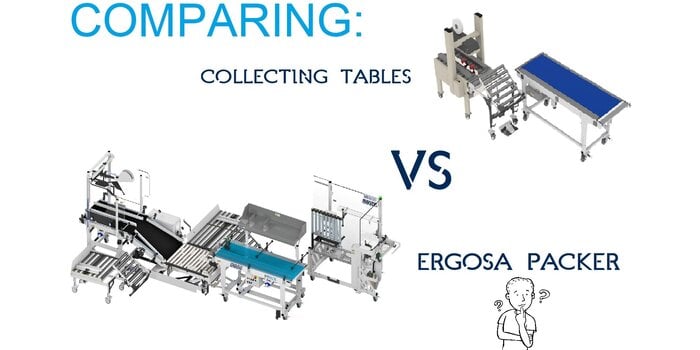
Let’s address the elephant in the room that most packaging producers avoid talking about :
![What is a Semi-Automatic Packer and How Can It Improve My Packing Process? [+ VIDEO]](https://impack.ca/hubfs/X21-057.png)
If you’re looking for ways to improve your folder-gluer’s productivity, increase your folder-gluer’s output, and reach higher speeds, you’re probably...
![Folder-Gluer Packers: What Level of Automation Is Right for You? [+VIDEO]](https://impack.ca/hubfs/X22-039-1.png)
Are you considering investing in a folder-gluer packer or folder-gluer stacker?